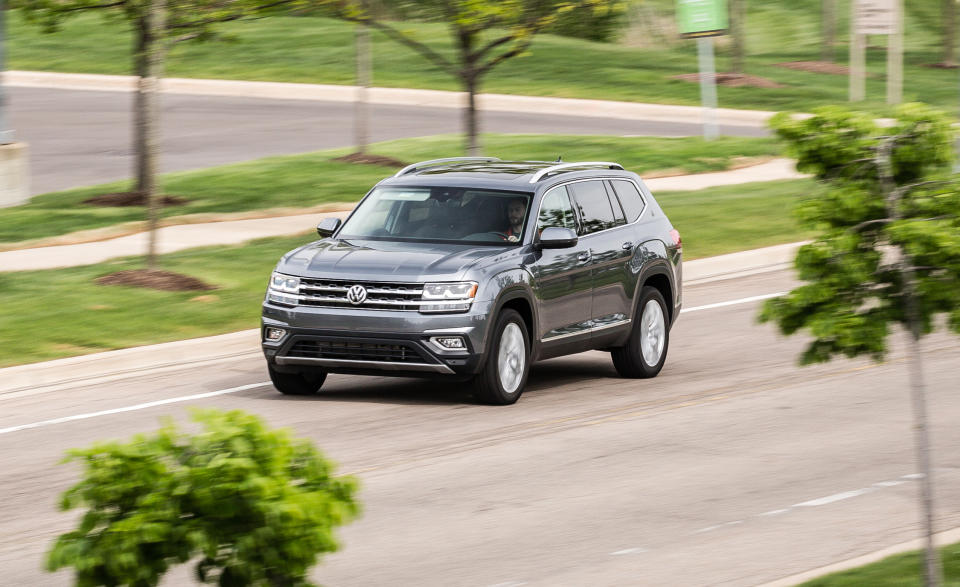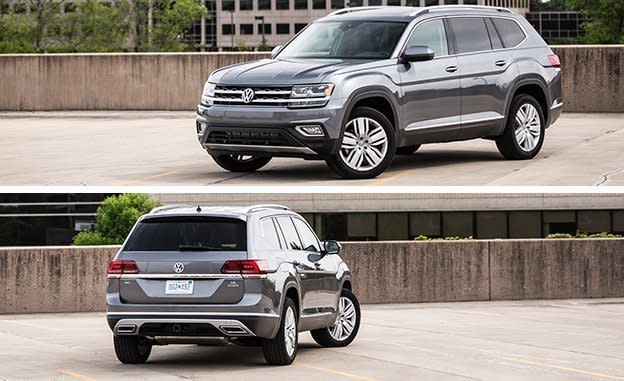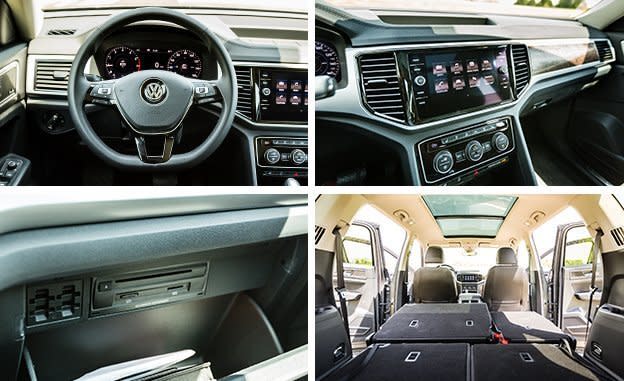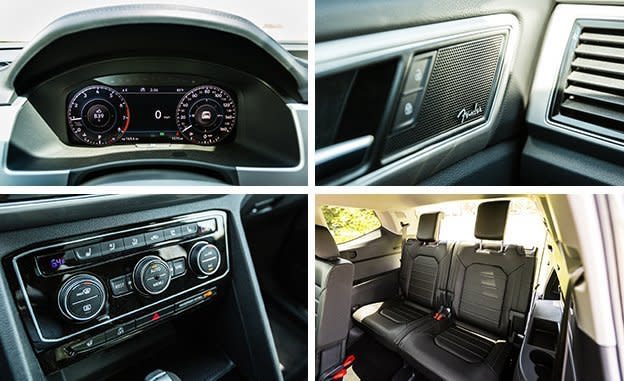2018 Volkswagen Atlas V-6 4MOTION

For several decades now, selling SUVs to Americans has been about as easy as peddling ice-cold lemonade on a hot summer day. But not for Volkswagen. VW introduced its first SUV, the Touareg, in 2003, and followed up with the smaller Tiguan a few years later. Neither caught on. Over 14 years, VW has sold fewer than 400,000 copies of those two models in total; for perspective, consider that Honda sold almost 360,000 CR-Vs just last year.
VW now seems to be overcompensating with the new-for-2018 Atlas. While the somewhat unconventional Tiguan and Touareg were always too expensive and too, well, European to have wide appeal here, the Atlas aims directly at the American-style three-row crossover bullseye. Its name is appropriately adventurous-sounding (and easy to pronounce); it’s massive, with a nearly 200-inch length that makes for a cavernous seven-seat interior; and it looks blocky and trucky—somewhat similar to the Ford Explorer, the current sales leader.

Room Galore
Unlike the space-inefficient Ford, the VW’s squared-off shape pays dividends inside. The Atlas’s interior is airy and open, with oodles of room for legs, feet, and elbows in all three rows. Seven seats are standard courtesy of a three-seat second-row bench and a two-place third row, while a $625 option for second-row captain’s chairs (available later this year) reduces that capacity to six.
There’s no eight-seat arrangement as in the Honda Pilot, but the Atlas is otherwise one of the most accommodating non-minivan people-carriers on the market. The second-row bench is nicely padded and when slid to its rearmost position has sufficient space for adults to cross their legs. The third row is easy to get into thanks to a fold-and-slide function for the second row that creates a generously sized portal. And, beyond the plentiful space for the sixth and seventh passengers, what’s more impressive is that the Atlas’s third-row seats don’t force adults’ bodies into awkward, contortionist positions. The bottom cushions are high enough that your knees won’t be at your chest, and the backrest angle is comfortable even for longer trips.
Looking to haul nonhuman cargo? The Atlas continues to please: There’s a useful 21 cubic feet of space behind the third row; a cavernous 56 cubic feet behind the second row; and a downright massive 97 cubic feet with all seatbacks folded to create a continuous, flat floor. Each of those figures is near the top of the class.

Proven Bones
We’re not surprised at Volkswagen’s packaging acumen, given that the Atlas derives its bones from VW’s MQB platform that is used in many VW and Audi products. Yes, really: This behemoth shares its basic suspension layout and select other hard points with the VW Golf hatchback, also a paragon of space efficiency.
While we wouldn’t go so far as to say that the Atlas drives like a Golf, it does share a sense of solidity that we’ve come to expect from Volkswagen. Ride quality is sublime, with just the right amount of compliance, luxury-car-like wheel control, and a stiff structure that soaks up impacts without any hint of reverberation. The trade-off for that ride quality, not surprisingly, is a considerable amount of body roll; even when pushed, though, the Atlas remains predictable and secure, turning in a solid 0.84 g around the skidpad, and stopping from 70 mph in a competitive 174 feet.

Familiar VW hardware resides under the hood, too, in the form of a 3.6-liter narrow-angle V-6 making 276 horsepower and 266 lb-ft of torque, mated to an eight-speed automatic transmission. This drivetrain proved less than energetic in our fully loaded, all-wheel-drive Atlas SEL Premium test car, motivating its 4728 pounds to 60 mph in a lackadaisical 7.9 seconds—the Honda Pilot and GMC Acadia are nearly two seconds quicker. The Atlas also lags in fuel economy, averaging 19 mpg in our hands and 24 mpg in our real-world 75-mph highway fuel-economy test, in which the V-6 Pilot and the turbo four-cylinder Mazda CX-9 recorded 26 mpg. The Atlas soon will offer a more efficient turbocharged 2.0-liter four, but only with front-drive and on lower trim levels.
Polished and Premium
This six-cylinder is refined enough for us to forgive its sluggishness, with smooth throttle tip-in, an intuitive automatic transmission that performs nearly imperceptible shifts, and low amounts of noise, vibration, and harshness. A bit of excess wind noise on the highway is the only hiccup in an otherwise quiet, polished, and luxurious driving experience.

Luxurious also describes the Atlas’s price, at least in its fully loaded SEL Premium form, which just slides in under $50,000. If $50,000 for a Volkswagen seems like a tough pill to swallow, remember that mid-size SUVs from Chevrolet, Ford, and Dodge are similarly pricey. The top-level Atlas also comes with a high level of equipment, such as adaptive cruise control, a 360-degree camera system, remote start, three-zone climate control, a Fender-branded audio system, and an easy-to-use 8.0-inch touchscreen infotainment system with Apple CarPlay and Android Auto. With some cheap plastics found on the door panels and tacky-looking fake wood on the dash, however, the Atlas’s interior quality reminds us less of the polished Euro-centric Golf and more of the cheapened cabins of the American-made Jetta and Passat.
Like the latest Tennessee-built Passat, Atlas is tailored to the American market and is built here. But unlike Passat, it doesn’t replace a slow-selling Euro-tuned model (the Touareg will continue here), so those who prefer the latter can still find it, at a price. VW is clearly operating outside of its comfort zone with Atlas, but it has created a competitive three-row SUV with the right priorities for its audience. With a cavernous interior, solid driving dynamics, and vaguely rugged styling, the Atlas is finally an SUV from Volkswagen that hits its mark.
Specifications >
VEHICLE TYPE: front-engine, all-wheel-drive, 7-passenger, 4-door hatchback
PRICE AS TESTED: $49,415 (base price: $34,625)
ENGINE TYPE: DOHC 24-valve V-6, iron block and aluminum head, direct fuel injection
Displacement: 220 cu in, 3597 cc
Power: 276 hp @ 6200 rpm
Torque: 266 lb-ft @ 2750 rpm
TRANSMISSION: 8-speed automatic with manual shifting mode
DIMENSIONS:
Wheelbase: 117.3 in
Length: 198.3 in
Width: 78.3 in Height: 70.0 in
Passenger volume: 153 cu ft
Cargo Volume: 21 cu ft
Curb weight: 4728 lb
C/D TEST RESULTS:
Zero to 60 mph: 7.9 sec
Zero to 100 mph: 20.2 sec
Zero to 110 mph: 25.3 sec
Rolling start, 5–60 mph: 8.2 sec
Top gear, 30–50 mph: 3.9 sec
Top gear, 50–70 mph: 5.2 sec
Standing ¼-mile: 16.0 sec @ 89 mph
Top speed (governor limited): 116 mph
Braking, 70–0 mph: 174 ft
Roadholding, 300-ft-dia skidpad*: 0.84 g
FUEL ECONOMY:
EPA combined/city/highway: 19/17/23 mpg
C/D observed: 19 mpg
C/D observed 75-mph highway driving: 24 mpg
C/D observed highway range: 440 mi
*stability-control-inhibited

 Yahoo Autos
Yahoo Autos 